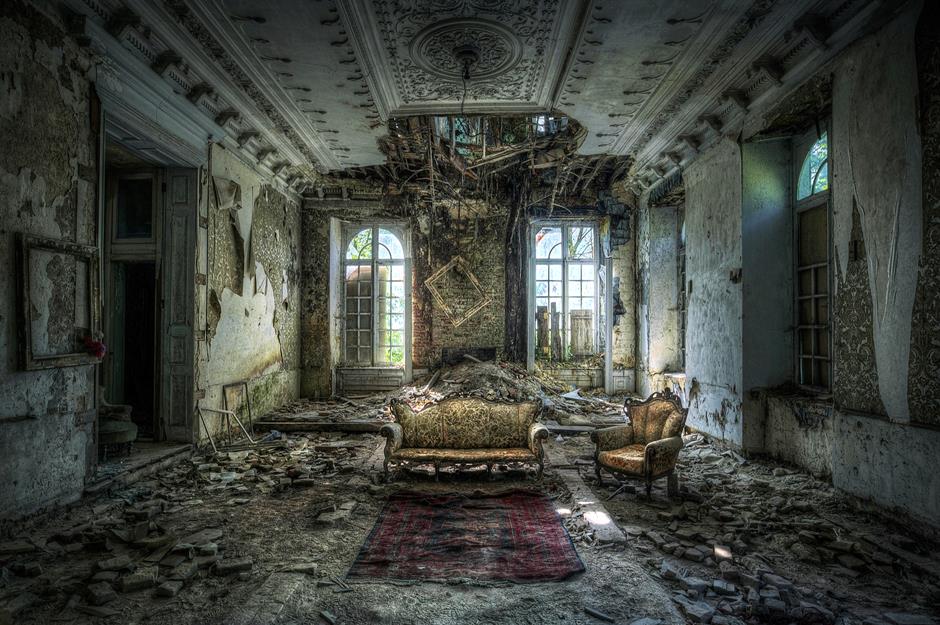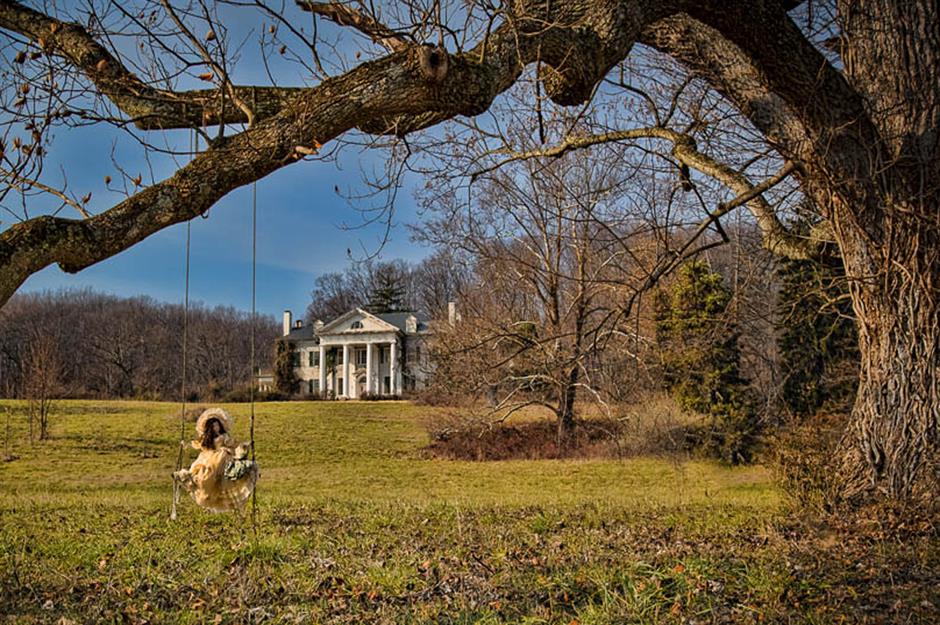Inside creepy abandoned mansions around the world (copy)
Enter these hair-raising houses at your own risk...
Selma Mansion, Virginia, USA
Ghosts are said to roam the rooms and corridors of this venerable plantation house in Leesburg, Virginia. Constructed in 1902, the 20-room Colonial Revival mansion had its heyday in the 1920s, hosting grand balls and dinner parties that were the talk of the state.
Selma Mansion, Virginia, USA
The original owner, Elijah Brokenborough, bequeathed the property to his daughter Jane Elizabeth, who lived in the mansion until her death in 1970. The house passed through several proprietors before it was abandoned in the early 2000s.
Selma Mansion, Virginia, USA
When Jane left, the Selma Mansion began to fall apart. Exposed to the elements with its windows broken and roof caving in, the crumbling house was slowly reclaimed by Mother Nature and many of the period features were smashed up or stolen by vandals and thieves.
Selma Mansion, Virginia, USA
Fortunately, the property was added to Preservation Virginia's most at-risk properties list in 2009 and it was eventually snapped up by local couple Sharon Virts and Scott Miller, who are in the process of restoring the historic mansion to its former glory.
Château Miranda, Celles, Belgium
The eerie neo-Gothic Château Miranda in Celles, Belgium was built in 1866 by English architect Edward Milner for the aristocratic Liedekerke-Beaufort family. These doomed aristocrats lost their original seat, the Château de Vêves, during the French Revolution.
Château Miranda, Celles, Belgium
The family were forced to give up their home for good in the Second World War when it was taken over by the Nazis. After the war, the property was renamed Château de Noisy and repurposed as an orphanage and holiday camp. The château was last used as a school before it was abandoned in 1991.
Château Miranda, Celles, Belgium
Plagued by neglect and vandalism, the abandoned stately home was severely damaged by a fire in 1995, and in 2006 a freak storm destroyed much of what was left of the roof. A decade later, local developer Luc Lavroff had ambitious plans to dismantle the structure and rebuild it in Spain. Work began in earnest on taking the château apart.
Château Miranda, Celles, Belgium
Pidhirtsi Castle, Pidhirtsi, Ukraine
The Ukraine's creepiest country pile, Pidhirtsi Castle was built between 1635 and 1640 for Grand Crown Hetman Stanisław Koniecpolski of the Polish-Lithuanian Commonwealth. The stately home passed through several owners until the First World War when it was captured by Russian troops who looted most of its contents.
Pidhirtsi Castle, Pidhirtsi, Ukraine
Pidhirtsi Castle, Pidhirtsi, Ukraine
The castle was then claimed by Prince Roman Sanguszko of Poland, who resided at the property during the interwar years before fleeing at the outbreak of the Second World War. Following the war, it was confiscated by the Soviets and served as a tuberculosis sanatorium.
Pidhirtsi Castle, Pidhirtsi, Ukraine
A catastrophic fire devastated the castle in 1956 and the property was abandoned. After lying empty for decades, the abandoned European palace was bought in 1997 by the Lviv Gallery of Arts and converted into a museum. While the castle is still in pretty bad shape, the gallery has embarked on a major restoration, which is ongoing.
Dundas Castle, New York, USA
Dundas Castle, New York, USA
A year later, Wurts-Dundas' bereft widow Josephine was committed to an asylum and the half-finished property passed to the couple's daughter Muriel, who was reportedly duped out of her inheritance and eventually moved to England where her mental health went downhill. The castle remained unfinished, despite the work that had already been lavished on it, as these photos show.
Dundas Castle, New York, USA
The estate of Muriel Wurts-Dundas eventually sold the property in 1949. It was snapped up by the Prince Hall Grand Lodge of the Masonic Order and used as a masonic retreat and holiday camp until the 1970s when it was largely abandoned. The castle has sat empty ever since.
Dundas Castle, New York, USA
Today, the abandoned castle, which is listed on the National Register of Historic Places, is out of bounds to the public and guarded by a caretaker. It is said to be haunted by the ghost of Josephine Wurts-Dundas and according to local legend, the water in the ponds on the estate turn to blood when the moon is full.
Château Burrus, Sainte-Croix-aux-Mines, France
This splendid and sinister neo-Baroque château in Alsace was built in 1900 for tobacco magnate and philanthropist Jules Burrus. The property was inherited in 1911 by his son Marcel who held onto it until the First World War.
Château Burrus, Sainte-Croix-aux-Mines, France
After Burrus refused to supply the German army with free cigarettes, the château was requisitioned as punishment and the tobacco heir fled to neutral Switzerland. Burrus reclaimed his home after the war, but it was confiscated yet again by the Germans in the Second World War and used as a training centre for SS officers.
Château Burrus, Sainte-Croix-aux-Mines, France
Château Burrus, Sainte-Croix-aux-Mines, France
Also known as Château Lumière on account of its wonderful light-filled rooms, the abandoned mansion has been more or less unmaintained since the 1990s. Sadly, it has succumbed to vandalism and is positively crying out for an extensive restoration.
Mystery mansion, New York, USA
This unsettling mansion, which is situated in a mystery location in New York State just a few miles away from the Big Apple, was accessed in 2016 by renowned abandoned buildings photographer Bryan Sansivero.
Mystery mansion, New York, USA
The 57-room mummified mansion, which dates from the 1930s, was abandoned in 1976 by its owner, who was known to acquire grand houses and bizarrely leave them to crumble. Looking like a horror movie set, the house remains eerily frozen in time.
Mystery mansion, New York, USA
Mystery mansion, New York, USA
Vandals have scrawled graffiti on some of the walls, the paintwork is peeling off and some of the windows are broken, letting the elements into the once-grand interior. Aside from these issues, the mansion is in surprisingly good shape.
Kościelniki Górne Palace, Kościelniki Górne, Poland
Constructed in the 18th century, Kościelniki Górne Palace, which was known as Schloss Ober Steinkirch before the Second World War, is located in Poland's Lower Silesian Voivodeship, a province that's famed for its multitude of abandoned mansions.
Kościelniki Górne Palace, Kościelniki Górne, Poland
The urban explorer crew Broken Window Theory scouted the dilapidated building a few years ago and found it in a frightful state. The province in which the palace is located was part of Germany before the Second World War and the last family to live there, the von Carnaps, were evicted in 1945.
Kościelniki Górne Palace, Kościelniki Górne, Poland
The palace was taken over by the Polish government and converted into offices and apartments for the collective State Agricultural Farms organisation. The property was abandoned in the early 1990s following the collapse of Communism and acquired in 2004 by a developer who sought to transform it into either an artist's retreat or a rehab centre.
Kościelniki Górne Palace, Kościelniki Górne, Poland
The renovation works were halted by the Polish authorities in 2008 as the owner failed to obtain the appropriate permits. Since then, the abandoned building has been left to wrack and ruin, and vandals and squatters have pretty much destroyed what were once beautiful rooms adorned with exquisite original features.
Château de Vyle-et-Tharoul, Vyle-et-Tharoul, Belgium
Dating back to the late 18th century, this Louis XV-style château in the sleepy Belgian village of Vyle-et-Tharoul was largely reconstructed during the 1820s by the Lamarche-Francotte family, who like the aforementioned Burrus clan, were rich tobacco tycoons.
Château de Vyle-et-Tharoul, Vyle-et-Tharoul, Belgium
Also known as Château Congo, the property was later owned by Count Alphonse de Meeus and stayed in the aristocratic de Meeus family until the Second World War when it was confiscated by the Nazis. After the German Army retreated from Belgium, the château was taken over by American forces.
Château de Vyle-et-Tharoul, Vyle-et-Tharoul, Belgium
Following the war, the property was purchased by an entrepreneur who had made a fortune in Africa, hence the château's alternative name, but the fortune was soon lost. The owner was unable to pay for maintenance and as a result, the property deteriorated into an appalling state. It was finally abandoned in 2010.
Château de Vyle-et-Tharoul, Vyle-et-Tharoul, Belgium
As luck would have it, this is one abandoned fairytale château that boasts a happy ending after all. In 2016, the property was bought by local public works company Cop & Portier and is in the process of being converted into 15 upscale apartments.
Captain William Tyson House, Rochelle Park, USA
This imposing 17-room mansion in Bergen County, New Jersey was built in 1864 for wealthy seafarer Captain William Tyson and his family. It's one of the last surviving grand 19th-century Italianate-style houses in the area.
Captain William Tyson House, Rochelle Park, USA
Steeped in faded grandeur and an eerie ambience, the endangered historic house retains many of its fine period features, and while the exterior was covered in artificial shingle in the 1950s, a conservation no-no, the mansion is as alluring as ever.
Captain William Tyson House, Rochelle Park, USA
Captain William Tyson House is included on Preservation New Jersey's 2018 10 Most Endangered Historic Properties list for good reason. It was snapped up in 2015 by the Township of Rochelle Park, which at the time, intended to bring it back to life by restoring its interiors. Since then, the make-up of the Rochelle Park Township committee has changed and the house was listed for sale in 2019.
Captain William Tyson House, Rochelle Park, USA
Much to the chagrin of the local historical society, the Township has removed restrictions that would require the new owner to preserve the building but is considering putting an easement on the property to prevent it from being demolished.
Château des Trois-Poètes, Castétis, France
Château des Trois-Poètes, Castétis, France
The seat of the noble Nays-Candau family, the château was passed down from generation to generation. The last owner, Mademoiselle de Sailly, a descendant of the clan, vacated the property in the mid-20th century.
Château des Trois-Poètes, Castétis, France
The château served as a hotel before it was converted into a retirement home in 1988. The 'maison de retraite' closed down in 2000 and since then the property has been left to decay. It is currently in an extremely poor state of disrepair.
Château des Trois-Poètes, Castétis, France
The local authority has plans to restore the château but currently, the building remains empty and decrepit. Like a scene from a terrifying horror film, discarded wheelchairs litter its corridors, old furniture sits rotting away in rooms and paint is peeling off the walls.
Harley Clarke Mansion, Illinois, USA
This foreboding French Eclectic-style mansion, which is located on Lighthouse Beach in Evanston, Illinois, was constructed in 1927 for mega-wealthy utility magnate Harley Clarke, who went on to become the president of the Fox Film movie studio.
Harley Clarke Mansion, Illinois, USA
No expense was spared on the 16-room limestone mansion, which commands an enviable position backing on to Lake Michigan. Clarke resided at the property with his family until 1949. A victim of the Great Depression, he was forced to sell his beloved mansion to the Sigma Chi fraternity.
Harley Clarke Mansion, Illinois, USA
The house was sold by the frat organisation to Evanston’s City Council in 1964 and repurposed as the Evanston Art Center. After the nonprofit moved to a new premises in 2015, the dilapidated dream home was left vacant and in desperate need of a revamp.
Harley Clarke Mansion, Illinois, USA
The mansion narrowly escaped demolition last year when the Evanston Preservation Committee voted unanimously to deny the council permission to raze it to the ground. Thankfully, the council is allowing nonprofit organisations such as Evanston Community Lakehouse & Gardens (ECLG) to tender proposals for the property. Watch this space!
Loved this? Like and follow us on Facebook for more amazing abandoned homes

